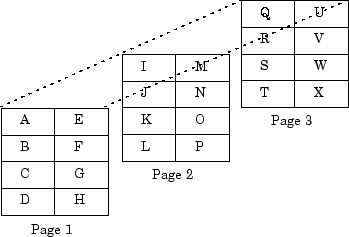在 C/C++ 客户端中管理 MATLAB 数据
MATLAB 数组
MATLAB® Runtime 使用单一对象类型:MATLAB 数组。所有 MATLAB 变量(包括标量、向量、矩阵、字符数组、元胞数组、结构体和对象)都存储为 MATLAB 数组。在 MATLAB Production Server™ C/C++ 客户端 API 中,MATLAB 数组被声明为 mpsArray 类型。mpsArray 结构体包含有关数组的以下信息:
类型
维度
与数组关联的数据
如果是数值,则变量是实数还是复数
如果稀疏,其索引和非零最大元素
如果是结构体或对象,则字段数和字段名称
要访问 mpsArray 结构体,请使用 mpsArray API 函数。这些函数使您能够创建、读取和查询有关客户端使用的 MATLAB 数据的信息。
注意
mpsArray API 镜像 MATLAB Compiler SDK™ 和 MATLAB 外部接口使用的 mxArray API。
数据存储
MATLAB 以列主(按列)编号方案存储数据。MATLAB 在内部首先存储第一列的数据元素,然后存储第二列的数据元素,依此类推,直到最后一列。
例如,给定矩阵:
a=['house'; 'floor'; 'porch'] a = house floor porch
其尺维度为:
size(a)
ans =
3 5其数据存储为:

如果矩阵是 N 维的,则 MATLAB 表示 N 主序的数据。考虑一个三维大写字母数组,其尺寸为 4×2×3。您可以在三页 4×2 矩阵中可视化数据,如下图所示:

MATLAB 内部按以下顺序表示此三维数组的数据:
| A | B | C | D | E | F | G | H | I | J | K | L | M | N | O | P | Q | R | S | T | U | V | W | X |
| 0 | 1 | 2 | 3 | 4 | 5 | 6 | 7 | 8 | 9 | 10 | 11 | 12 | 13 | 14 | 15 | 16 | 17 | 18 | 19 | 20 | 21 | 22 | 23 |
mpsCalcSingleSubscript() 函数使用 N 维下标创建从数组的第一个元素到所需元素的偏移量。
注意
MATLAB 索引从 1 开始,而 C 索引从 0 开始。
MATLAB 类型
复数双精度矩阵
复数双精度非稀疏矩阵为 double 类型,维数为 m×n,其中 m 是行数,n 是列数。数据存储为两个双精度数字向量 - 一个包含实部数据,一个包含虚部数据。指向该数据的指针分别称为 pr(指向实数数据的指针)和 pi(指向虚数数据的指针)。非复数矩阵是 pi 为 NULL 的矩阵。
数值矩阵
数值矩阵是单精度浮点整数,可以是 8 位、16 位、32 位和 64 位,有符号和无符号。数据以与双精度矩阵相同的方式存储在两个向量中。
逻辑矩阵
logical 数据类型分别使用数字 true 和 false 表示逻辑 1 或 0 状态。某些 MATLAB 函数和运算符返回逻辑 1 或逻辑 0 来指示某个条件是否为真。例如,语句 (5 * 10) > 40 返回逻辑 1 值。
MATLAB 字符数组
MATLAB 字符数组属于 char 类型,其存储方式与无符号 16 位整数类似,但没有虚部数据组件。与 C 不同,MATLAB 字符数组不以空值终止。
元胞数组
元胞数组是 MATLAB 数组的集合,其中每个 mpsArray 称为一个元胞,从而可以将不同类型的 MATLAB 数组存储在一起。元胞数组的存储方式与数值矩阵类似,只是数据部分包含指向 mpsArray 的单个指针向量。此向量的成员称为元胞。每个元胞可以是任何受支持的数据类型,甚至是另一个元胞数组。
结构体
结构是 MATLAB 数组,其元素由文本字段指示符访问。
以下是在 MATLAB 中如何创建结构体的示例:
S.name = 'Ed Plum'; S.score = 83; S.grade = 'B+'
创建一个具有三个字段的标量结构体:
S =
name: 'Ed Plum'
score: 83
grade: 'B+'
1×1 结构体的存储方式与 1×n 元胞数组相同,其中 n 是结构体中的字段数。数据向量的成员称为字段。每个字段都与存储在 mpsArray 中的名称相关联。
多维数组
多维数组是一个整数向量,其中每个元素都是相应维度的大小。数据的存储与矩阵相同。任何类型的 MATLAB 数组都可以是多维的。
空数组
任何类型的 MATLAB 数组都可以为空。空的 mpsArray 至少有一个维度等于零。例如,类型为 mpsArray 的双精度 double,其中 m 和 n 等于 0,而 pr 为 NULL,是一个空数组。
稀疏矩阵
稀疏矩阵与 MATLAB 中的满矩阵具有不同的存储约定。参数 pr 和 pi 仍然是双精度数字数组,但这些数组只包含非零数据元素。还有三个附加参数:
nzmax是一个整数,包含ir、pr以及(如果存在)pi的长度。它是稀疏矩阵中非零元素的最大数量。ir指向长度为nzmax的整数数组,其中包含pr和pi中对应元素的行索引。jc指向长度为n+1的整数数组,其中 n 是稀疏矩阵中的列数。jc数组包含列索引信息。如果稀疏矩阵的第j列有任何非零元素,则jc[j]是第ir列中第一个非零元素在pr和pi(以及j,如果存在)中的索引,而jc[j+1] - 1是该列中最后一个非零元素的索引。对于稀疏矩阵的第j列,jc[j]是所有前列中非零元素的总数。jc数组的最后一个元素jc[n]等于nnz,即整个稀疏矩阵中非零元素的数量。如果nnz小于nzmax,则可以将更多非零条目插入数组中,而无需分配更多存储空间。
使用数据类型
您可以用 C/C++ 编写 MATLAB Production Server 客户端应用程序,接受 MATLAB 支持的任何类或数据类型(请参阅 MATLAB 类型)。
小心
MATLAB Runtime 不会检查用 C/C++ 创建的 MATLAB 数据结构体的有效性。使用无效语法创建 MATLAB 数据结构体可能会导致意外行为。
声明数据结构
要处理 MATLAB 数组,请使用类型 mpsArray。以下语句声明一个名为 mpsArray 的 myData:
mpsArray *myData;
要定义 myData 的值,请使用 mpsCreate* 函数之一。一些有用的数组创建例程是 mpsCreateNumericArray()、mpsCreateCellArray() 和 mpsCreateCharArray()。例如,以下语句分配一个 m×1 浮点 mpsArray 并初始化为 0:
myData = mpsCreateDoubleMatrix(m, 1, mpsREAL);
C/C++ 程序员应该注意 MATLAB 数组中的数据是按列主序排列的。(有关插图,请参阅数据存储。)使用 mpsGet* 数组访问例程从 mpsArray 读取数据。
操作数据
mpsGet* 数组访问例程获取对 mpsArray 中数据的引用。使用这些例程来修改客户端应用程序中的数据。每个函数提供对 mpsArray 中特定信息的访问。一些有用的函数是 mpsGetData()、mpsGetPr()、mpsGetM() 和 mpsGetString()。以下语句将输入字符数组 prhs[0] 读入 C 样式字符串 buf:
char *buf; int buflen; int status; buflen = mpsGetN(prhs[0])*sizeof(mpsChar)+1; buf = malloc(buflen); status = mpsGetString(prhs[0], buf, buflen);